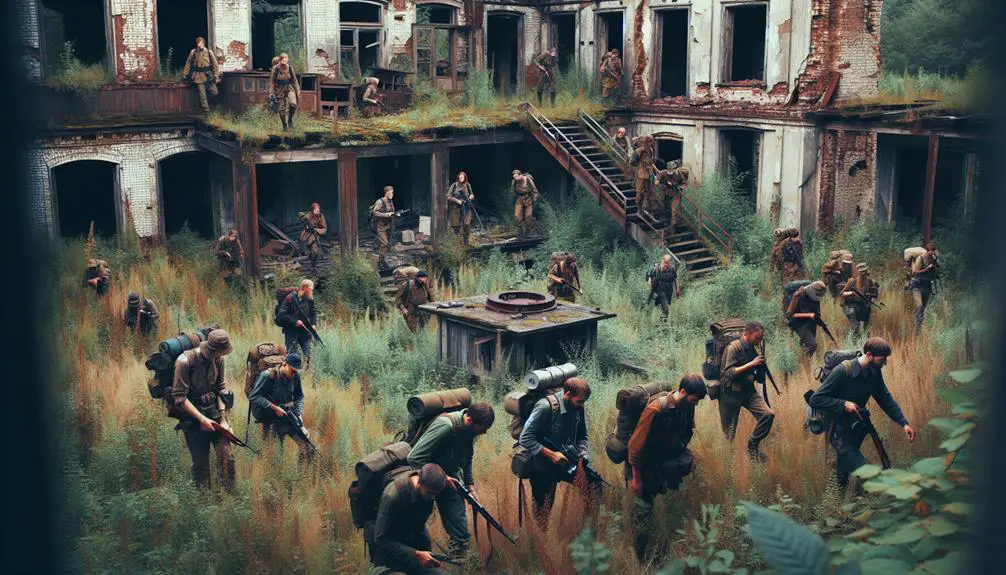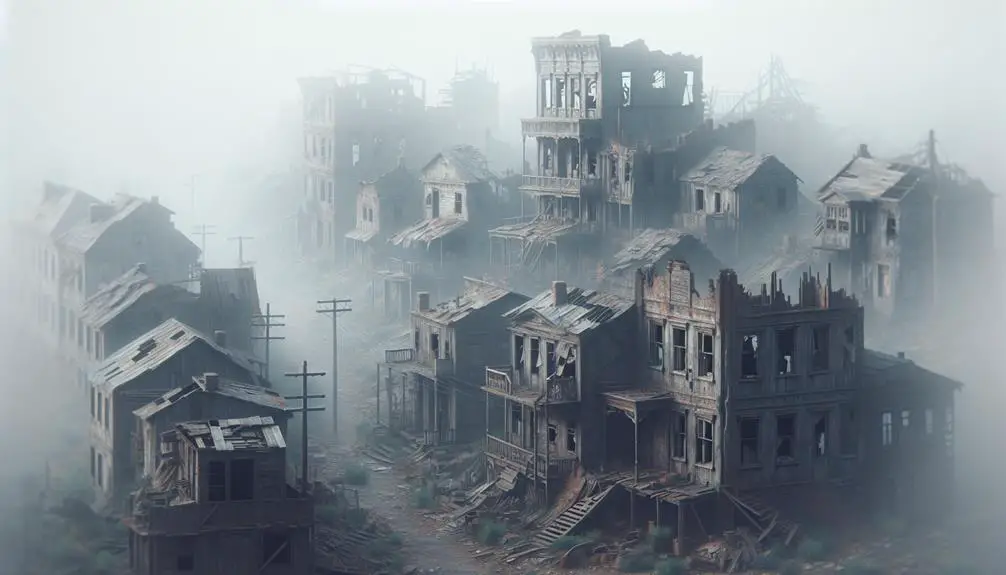Civil War ghost towns exist today due to wartime destruction, economic decline, and changing demographics. These factors led to towns being abandoned and facing preservation challenges. Efforts to stabilize structures and secure funding are ongoing. Haunting legends stem from the tragic history of these places, attracting visitors intrigued by the supernatural. Tourism sustains local economies and educates about historical impacts. The significance of these ghost towns lies in their role as tangible reminders of past hardships and losses. Understanding their origins sheds light on the complex interplay of war, economics, and human migration.
Key Points
- Wartime destruction and economic decline led to abandonment.
- Shifts in demographics and job opportunities caused population declines.
- Environmental challenges and infrastructure destruction contributed to ghost town status.
- Preservation efforts face funding and resource challenges.
- Haunting legends and folklore surround these abandoned towns.
Origins of Civil War Ghost Towns
Have you ever wondered how Civil War ghost towns came to be? The origins of these haunting reminders lie in the dual impact of wartime destruction and economic downturn. During the Civil War, many towns and communities became battlegrounds, facing immense destruction as a result of military strategies, raids, and conflicts. This widespread devastation left once-thriving areas in ruins, with infrastructure destroyed and homes left abandoned. The economic downturn following the war further exacerbated the situation, as industries struggled to recover, businesses closed, and populations dwindled as people sought opportunities elsewhere.
The combination of wartime destruction and economic hardships created a perfect storm for the birth of Civil War ghost towns. These towns, once bustling with life, were left deserted and eerily quiet, their remnants standing as poignant reminders of the past. The proof of these ghost towns serves as a testimony to the profound impact of war and economic instability on communities, showcasing the lasting effects that reverberate through history.
Factors Contributing to Abandonment
The abandonment of Civil War ghost towns can be attributed to a combination of factors, including wartime destruction, economic downturn, and shifting demographics.
- Wartime Destruction: The ravages of war left many towns in ruins, making it challenging for residents to rebuild and continue living in these areas.
- Economic Decline: Following the Civil War, many regions experienced economic hardship, leading to a decline in industries and job opportunities, prompting residents to seek livelihoods elsewhere.
- Shifting Demographics: The aftermath of the war caused significant population shifts as people moved to more prosperous areas, leaving behind once-thriving communities to dwindle into ghost towns.
- Environmental Disasters: Some Civil War ghost towns faced environmental challenges such as soil degradation, water source contamination, or natural disasters, making it difficult for inhabitants to sustain their way of life.
These factors combined contributed to the abandonment of Civil War ghost towns, creating a haunting reminder of the past struggles and hardships faced by those who once called these places home.
Preservation Efforts and Challenges
Preserving Civil War ghost towns presents a unique set of challenges amidst ongoing efforts to safeguard these historical sites. One of the primary challenges faced in preserving these ghost towns is the delicate balance between maintaining authenticity and preventing further deterioration. Preservation techniques often involve stabilizing structures to prevent collapse, implementing measures to protect against natural elements such as erosion and decay, and conducting regular maintenance to guarantee the longevity of the sites.
Challenges are also encountered in securing funding for preservation projects, as resources are often limited, and competing priorities exist for historical conservation efforts. Additionally, the remoteness of some ghost towns can make access difficult, further complicating preservation initiatives. Despite these challenges, dedicated individuals and organizations continue to work tirelessly to secure the survival of these important remnants of history.
Haunting Legends and Folklore
With a history rich in tragedy and conflict, Civil War ghost towns have become the subjects of haunting legends and folklore passed down through generations. These chilling tales of haunting spirits and supernatural encounters have contributed to the mystique surrounding these abandoned settlements.
Here are four reasons why the haunting legends and folklore of Civil War ghost towns continue to captivate the imagination:
- Ghostly Apparitions: Locals claim to have witnessed apparitions of soldiers and civilians roaming the deserted streets, adding to the eerie atmosphere of these ghost towns.
- Unexplained Sounds: Visitors have reported hearing unexplained sounds like phantom footsteps, disembodied voices, and the distant echoes of battle cries, heightening the sense of otherworldly presence.
- Cursed Artifacts: Many believe that artifacts left behind in these ghost towns are cursed, leading to stories of misfortune and tragedy befalling those who disturb them.
- Supernatural Encounters: Numerous accounts describe encounters with supernatural entities, from ghostly figures in old buildings to inexplicable lights flickering in the darkness, fueling the belief in the paranormal nature of these places.
Tourism Impact and Significance
As you explore the haunting legends and folklore surrounding Civil War ghost towns, the tourism impact and significance of these eerie remnants of the past become increasingly apparent. These ghost towns attract visitors seeking a glimpse into the historical events that unfolded during the Civil War era. The essential benefits that tourism brings to these desolate sites can't be overlooked. Local businesses, such as restaurants, hotels, and souvenir shops, thrive on the influx of tourists. Additionally, the preservation and maintenance of these sites are often funded through entrance fees and donations from visitors, ensuring their longevity for future generations.
Moreover, the tourism industry surrounding Civil War ghost towns plays a vital role in historical education. Visitors have the opportunity to learn about the struggles and sacrifices of those who lived through the Civil War period. Walking through the abandoned streets and buildings provides a tangible connection to the past, allowing for a deeper understanding of this significant period in American history. By experiencing these ghost towns firsthand, visitors gain a unique perspective on the impact of war on communities and the importance of preserving historical sites.
Frequently Asked Questions
Are There Any Reported Sightings of Paranormal Activity in Civil War Ghost Towns?
You'll find numerous reports of paranormal activity in civil war ghost towns. Paranormal investigations reveal haunted tours filled with supernatural phenomena. Folklore and local legends add layers of mystery to these eerie locations, sparking curiosity and fear.
What Is the Process for Obtaining Permission to Visit and Explore Civil War Ghost Towns?
To explore Civil War ghost towns, contact local historical societies or government agencies for exploration permits. Respect the history and preservation efforts by following guidelines. Enjoy the journey while honoring the past.
How Do Local Communities View and Interact With the Presence of Ghost Towns in Their Area?
Local communities engage with ghost towns for historical preservation. They view these sites as reminders of the past and often organize events to honor the area's history. Community engagement guarantees these locations are respected and remembered.
Have Any Archaeological Excavations Been Conducted in Civil War Ghost Towns to Uncover More About Their History?
Like a detective unraveling a mystery, you'll find that yes, archaeological excavations have been conducted in civil war ghost towns. These digs unearth valuable historical artifacts, shedding light on the past.
Are There Any Plans to Redevelop or Repurpose Civil War Ghost Towns for Modern Use in the Future?
Rehabilitation projects in ghost towns offer economic opportunities. Historical preservation combined with modern needs can revitalize these areas. Consider the potential for unique tourism, community development, or preserving heritage while creating new value.



